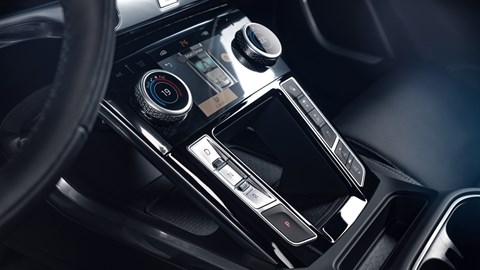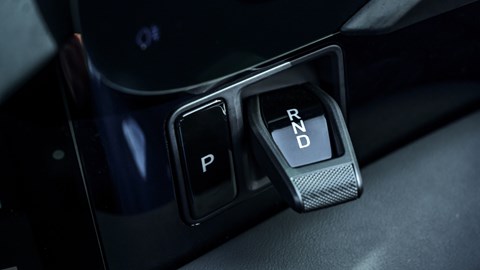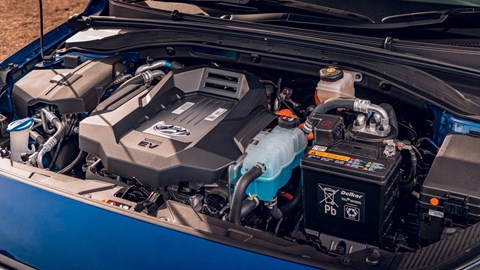Electric cars look like their combustion-engined counterparts from the outside, but they often feature a variety of very different solutions inside – and the problems extend to well beyond the engine. Unlike petrol or diesel engines, which are often connected to a gearbox with multiple gears – electric cars often utilise a single gear.
Why do ICE cars have gears?
Internal combustion engines can offer serious shove, but they tend to have very narrow power bands – which is why they’re usually connected to a gearbox. Each gear keeps the engine at a relative sweet-spot within its power band, making sure your car is responsive and torquey. Drive any petrol or diesel car using a single gear and you’ll either bounce off the rev limiter, or you won’t get anywhere at all.
EVs, however, tend to use a single gear setup meaning they don’t always need additional ratios. In this guide we’ll explain how EVs are geared, and why it’s not a simple case of manual versus automatic transmissions anymore.
Learn more about electric cars
How long do electric car batteries last?
How long does it take to charge an electric car?
Best electric cars
Future electric cars
Are electric cars automatic or manual?
The majority of EVs use a single gear, thanks to the greater efficiency and broader power band inherent in EV motors. Some electric cars will use use a reduction gear and differential to regulate power, so are neither manual nor automatic but instead simply geared. This set-up is found in most production EVs such as the Honda E and Audi e-Tron for example.

Single-speed gearboxes are also chosen for their strength. ‘Traditional gearboxes cannot cope with the instant torque from electric motors,’ said Chris Hazell, managing director of Zero EV. As an electric motor has 100% of its torque available at any point and can spin to 20,000rpm, a standard gearbox would simply break.
What’s an electric car like to live with? We ask owners
There are ways that EVs can behave as if they’re geared even if they’re running a single gear: Some Teslas make use of dual-motors with different ratios at the front and back to offer different ratios. Other manufacturers use throttle sensitivity and other variables to determine the pace of acceleration, again mimicking different gear ratios.
Two speed boxes
There is also an emergence of two-speed automatic gearboxes, particularly in the fastest electric cars. Porsche was the first to use a two-speed ‘box, in the Taycan; The first gear is reserved exclusively for quick launches and the second gear is used for everything else. Two-speed gearboxes could also emerge as a way of balancing performance and battery range in smaller electric cars cars.

To further complicate matters, some EVs can use traditional gearboxes. The Rimac C_Two uses two separate two-speed gearboxes for each rear wheel and a single-speed gearbox for the front wheels. But as a 258mph EV supercar, it probably won’t be your first choice if you’re looking to go electric for the first time.
What is B mode?
Electric cars don’t have a gearbox or gearstick, but they’ll often have a gear selector with Park, Reverse and Neutral, as well as a P button for Park. What’s more they’ll also have a separate drive mode – often called B mode. Selectable either via a dedicated button, or from the gear selector itself, B mode is an alternative drive mode, and increases the amount of regeneration achieved from the wheels.
Are there any manual electric cars?
No. Electric motors don’t have the same power band limitations as ICE powertrains, and that means they don’t need more than one gear. As you’d expect, that also means the need to develop a H-pattern shifter for an electric car is pretty remote.
But that doesn’t mean that manufacturers haven’t attempted to install manual gearboxes in EVs before. Prototype Tesla Roadsters had two-speed manual gearboxes until Tesla settled on a single-gear option while a six-speed manual EV Ford Mustang was displayed at SEMA in 2019.
What’s more, Toyota is also currently developing a ‘virtual gearbox’ that can give the impression of gearshifts in an EV.
We at CAR are unashamed fans of the old-fashioned manual gearbox so it will be interesting to see how a manual gearbox would feel in an EV and whether EVs could reignite interest in the manual gearbox.
Any benefits to no gears?
Electric cars have a few benefits over conventional cars when it comes to maintenance; for example, brake wear is often lower, as EVs also use regeneration to slow the car – as well as the brakes themselves. That means less wear and ideally less maintenance. As for the gearbox? It’s fair to say an EV’s gearbox is less complex than a conventional manual car’s, but the difference in maintenance between the two isn’t significant. After all, most modern gearboxes don’t require a huge amount of maintenance.
Opinion: The joy of the manual gearchange
Do electric cars have engines?
EVs do not have engines, instead they have electric motors. The difference between the two is that motors convert power into energy while engines convert fuel into energy. In this case, electric motors have two parts, the stator and the rotor. The stator creates a magnetic field from the energy from the batteries and this turns the rotor which turns the wheels. In the early days of EVs you may have heard of these motors being called ‘electric engines’ which is simply incorrect.

The lack of engine is part of the reason why EVs don’t need a clutch, there is no need to disengage from the motor because there is no risk of stalling. Electric motors work instantly so there is never a need to idle.
Would you want to drive an EV with a proper manual gearbox? Let us know in the comments below.